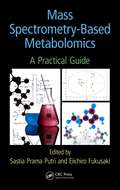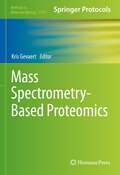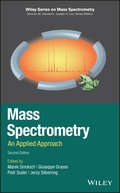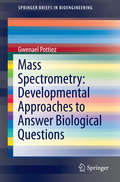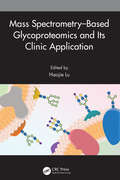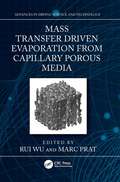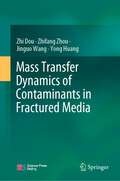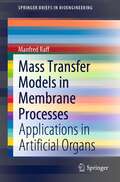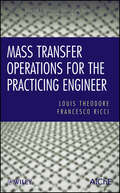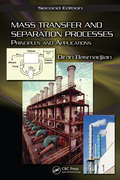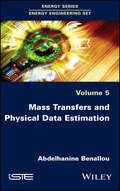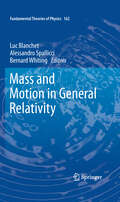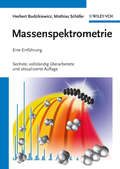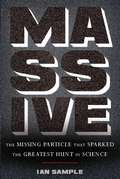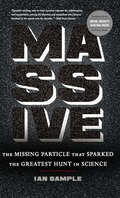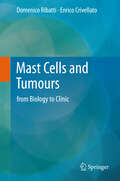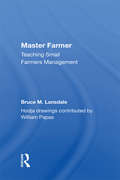- Table View
- List View
Mass Spectrometry-Based Metabolomics: A Practical Guide
by Sastia Prama Putri Eiichiro FukusakiMass Spectrometry-Based Metabolomics: A Practical Guide is a simple, step-by-step reference for profiling metabolites in a target organism. It discusses optimization of sample preparation for urine, serum, blood, tissue, food, and plant and animal cell samples. Encompassing three different technical fields-biology, analytical chemistry, and informa
Mass Spectrometry-Based Proteomics (Methods in Molecular Biology #2718)
by Kris GevaertThis detailed volume explores contemporary techniques in mass spectrometry-based proteomics. After covering overall proteome coverage and the cellular surfaceome, the book delves into proximity-induced biotinylation, abduction of protein complexes in viral-like particles, and thermal proteome profiling, as well as protocols for identifying protein N-terminal acetylation, protein processing by proteases, protein N-glycosylation, and protein phosphorylation. The book also collects chapters on automated preparation of clinical samples, the analysis of formalin-fixed paraffin-embedded samples, protocols for the isolation of extracellular vesicles and for the monitoring of selected protein modifications in clinical samples, and, finally, structural proteomics. Written for the highly successful Methods in Molecular Biology series, chapters include introductions to their respective topics, lists of the necessary materials and reagents, step-by-step and readily reproducible laboratory protocols, and tips on troubleshooting and avoiding known pitfalls. Authoritative and practical, Mass Spectrometry-Based Proteomics serves as an ideal guide to its subject for both novices in the field of proteomics as well as specialists.
Mass Spectrometry: An Applied Approach (Wiley Series on Mass Spectrometry #20)
by Marek Smoluch Giuseppe Grasso Piotr Suder Jerzy SilberringProvides a comprehensive description of mass spectrometry basics, applications, and perspectives Mass spectrometry is a modern analytical technique, allowing for fast and ultrasensitive detection and identification of chemical species. It can serve for analysis of narcotics, counterfeit medicines, components of explosives, but also in clinical chemistry, forensic research and anti-doping analysis, for identification of clinically relevant molecules as biomarkers of various diseases. This book describes everything readers need to know about mass spectrometry—from the instrumentation to the theory and applications. It looks at all aspects of mass spectrometry, including inorganic, organic, forensic, and biological MS (paying special attention to various methodologies and data interpretation). It also contains a list of key terms for easier and faster understanding of the material by newcomers to the subject and test questions to assist lecturers. Knowing how crucial it is for young researchers to fully understand both the power of mass spectrometry and the importance of other complementary methodologies, Mass Spectrometry: An Applied Approach teaches that it should be used in conjunction with other techniques such as NMR, pharmacological tests, structural identification, molecular biology, in order to reveal the true function(s) of the identified molecule. Provides a description of mass spectrometry basics, applications and perspectives of the technique Oriented to a broad audience with limited or basic knowledge in mass spectrometry instrumentation, theory, and its applications in order to enhance their competence in this field Covers all aspects of mass spectrometry, including inorganic, organic, forensic, and biological MS with special attention to application of various methodologies and data interpretation Includes a list of key terms, and test questions, for easier and faster understanding of the material Mass Spectrometry: An Applied Approach is highly recommended for advanced students, young scientists, and anyone involved in a field that utilizes the technique.
Mass Spectrometry: Developmental Approaches to Answer Biological Questions
by Gwenael PottiezThe understanding of the events taking place in a cell, a biological fluid or in any biological system is the main goal of biology research. Many fields of research use different technology to assess those events. Mass spectrometry is one of those techniques and this undergoes constant evolution and adaptation to always enhance the accuracy of the information provided. Proteomics provides a large panel of data on protein identity and protein expression that were made possible by mass spectrometry. For several years now mass spectrometry has become central to performing proteomic research, however this powerful tool is under constant evolution to be more sensitive and more resolute. More importantly mass spectrometry became a field of research focusing on new applications. Indeed, the complexity in biological systems relies on the changes of expression of transcription of proteins but also on the post-translational modification of proteins, the structure of proteins and the interaction between proteins, amongst others. As of now, several investigations tried to improve the quantification of proteins by mass spectrometry, the determination of post-translational modifications, the protein-protein and protein-nucleic acids interaction or the proteins structures. This book is structured as follows: after a brief introduction of the usual and most popular applications for mass spectrometry in proteomics, the most recent research and developments in mass spectrometry-based methodologies will be explored.
Mass Spectrometry–Based Glycoproteomics and Its Clinic Application
by Haojie LuAs one of the most extensive and important protein post-translational modifications, glycosylation plays a vital role in regulating organisms and is associated with various physiological and pathological processes. Recently, researchers have focused on the need to characterize protein glycosylation sites, structures, and their degree of modification, to better understand their biological functions while also looking for potential biomarkers for diagnosis and treatment of disease. Mass spectrometry (MS) is one of the most powerful tools used to study biomolecules including glycoproteins and glycans. With the continuous development of glycoproteomics and glycomics based on MS analysis, more techniques have evolved and contribute to understanding the structure and function of glycoproteins and glycans. This book reviews advancements achieved in MS-based glycoproteomic analysis, including a wide range of analytical methodologies and strategies involved in selective enrichment; as well as qualitative, quantitative, and data analysis, together with their clinical applications. Significant examples are discussed to illustrate the principles, laboratory protocols, and advice for key implementation to ensure successful results. Mass Spectrometry–Based Glycoproteomics and Its Clinic Application will serve as a valuable resource to elucidate new techniques and their applications for students, postdocs, and researchers working in proteomics, glycoscience, analytical chemistry, biochemistry, and clinical medicine. Editor: Haojie Lu is a professor at Fudan University, specializing in proteomics based on mass spectrometry with particular emphasis on novel technologies for separation and identification of low-abundant proteins and post-translationally modified proteins (including glycosylation), as well as relative and absolute quantification methods for proteomics.
Mass Term Effect on Fractional Quantum Hall States of Dirac Particles (Springer Theses)
by Kouki YonagaThis book presents the high-precision analysis of ground states and low-energy excitations in fractional quantum Hall states formed by Dirac electrons, which have attracted a great deal of attention. In particular the author focuses on the physics of fractional quantum Hall states in graphene on a hexagonal boron nitride substrate, which was recently implemented in experiments. The numerical approach employed in the book, which uses an exact numerical diagonalization of an effective model Hamiltonian on a Haldane’s sphere based on pseudopotential representation of electron interaction, provides a better understanding of the recent experiments. The book reviews various aspects of quantum Hall effect: a brief history, recent experiments with graphene, and fundamental theories on integer and fractional Hall effects. It allows readers to quickly grasp the physics of quantum Hall states of Dirac fermions, and to catch up on latest research on the quantum Hall effect in graphene.
Mass Transfer Driven Evaporation From Capillary Porous Media (Advances in Drying Science and Technology)
by Rui WuMass Transfer–Driven Evaporation from Capillary Porous Media offers a comprehensive review of mass transfer–driven drying processes in capillary porous media, including pore-scale and macro-scale experiments and models. It covers kinetics of drying of a single pore, pore-scale experiments and models, macro-scale experiments and models, and understanding of the continuum model from pore-scale studies. The book: Explains the detailed transport processes in porous media during drying. Introduces cutting-edge visualization experiments of drying in porous media. Describes the pore network models of drying in porous media. Discusses the continuum models of drying in porous media based on pore-scale studies. Points out future research opportunities. Aimed at researchers, students and practicing engineers, this work provides vital fundamental and applied information to those working in drying technology, food processes, applied energy, and mechanical and chemical engineering.
Mass Transfer Dynamics of Contaminants in Fractured Media
by Yong Huang Zhi Dou Zhifang Zhou Jinguo WangThis book focuses on many aspects of mass transfer dynamics of contamination in fractured media. First, it discusses the concept, structure and properties of fractured media. It then traces topics such as basic law of seepage in fractured media, the basic mass transfer theory of fractured media, numerical simulation of mass transfer process in fractured media, mathematical model and parameter inversion of mass transfer in fractured media and the frontier of mass transfer in fractured media. The book is a comprehensive reference for both graduate students and scientific and technological teams working in the fields of hydrogeology, water conservation, mining and civil engineering, environmental engineering, transportation, civil air defense and national defense.
Mass Transfer Models in Membrane Processes: Applications in Artificial Organs (SpringerBriefs in Bioengineering)
by Manfred RaffThis book serves as an introduction on mass transfer models in membrane processes, with a special focus on their applications in Artificial Organs. Various such models are discussed while multiple easy to use module equations are presented, enabling readers to gain basic knowledge of the mass flow of toxins across membranes. This is particularly interesting to membrane manufacturers who may use these equations to improve the relation of module performances and production costs. Additionally, examples which specialize on artificial organs, but in principle can be applied to analogous environmental, food and biotechnology processes- are analysed. This book will appeal to readers who want to understand how membrane modules and processes can be optimized and will be a great tool for graduates, researchers and professionals working in this field.
Mass Transfer Operations for the Practicing Engineer
by Louis Theodore Francesco RicciPart of the Essential Engineering Calculations Series, this book presents step-by-step solutions of the basic principles of mass transfer operations, including sample problems and solutions and their applications, such as distillation, absorption, and stripping. Presenting the subject from a strictly pragmatic point of view, providing both the principles of mass transfer operations and their applications, with clear instructions on how to carry out the basic calculations needed, the book also covers topics useful for readers taking their professional exams.
Mass Transfer and Separation Processes: Principles and Applications, Second Edition
by Diran BasmadjianMass transfer along with separation processes is an area that is often quite challenging to master, as most volumes currently available complicate the learning by teaching mass transfer linked with heat transfer, rather than focusing on more relevant techniques. With this thoroughly updated second edition, Mass Transfer and Separation Processes: Pr
Mass Transfers and Physical Data Estimation
by Abdelhanine BenallouMany practical operations, such as environment depollution, blood dialysis or product purification, require matter transfer. With an emphasis on the aforementioned subjects, this book revisits the founding principles of materials transfer on the basis of Fick’s first law, which constitutes the foundation of diffusional phenomena. Additionally, continuity equations translating the macroscopic balances of systems are established. These balances constitute Fick’s second law, which can be applied to quantify the fluxes of matter transferred in each situation, provided physical data is available. To this end, Mass Transfers and Physical Data Estimation pays particular attention to methods of data estimation. Methods presented in this book are applied to several practical cases, such as diffusion in catalytic reactions or the reconstitution of cartilage in human bone joints.
Mass Transport in Solids and Fluids
by David S. WilkinsonThe field of matter transport is central to understanding the processing of materials and their subsequent mechanical properties. This text gives a solid grounding in the principles of matter transport and their application to a range of engineering problems. The author develops a unified treatment of mass transport applicable to both solids and liquids. Traditionally, matter transport in fluids is considered as an extension of heat transfer and can appear to have little relationship to diffusion in solids. This unified approach clearly makes the connection between these important fields. Aimed at advanced undergraduate and beginning graduate students of materials science and engineering and related disciplines, the book contains numerous worked examples and unsolved problems.
Mass and Energy Balancing: Calculations for Plant Design
by David Pritchard Shaik FerozThe aim of this text is to provide a comprehensive set of calculations relating to mass and energy balances for an entire process plant. An ammonia synthesis plant will be taken as a calculation model to develop the relevant mass and energy balances necessary for the design and subsequent production, as the production of ammonia synthesis gas is an internationally used process. Instead of teaching the basics of mass and energy balances, the text aims to give a detailed series of process integrated and illustrated calculations to help readers develop and design a process plant. • Details complete mass and energy calculations related to a manufacturing plant and includes stepwise procedures for mass and energy balances • Demonstrates how the series of integrated calculations will lead to the production of a specified amount of final product • Features “teaching” appendices that lay out applications of prior-assumed knowledge, which can be used in conjunction with the main text where more detailed explanation may be needed • Contains problems linked to various manufacturing sections covered in the text to help readers consolidate their knowledge This book will serve undergraduate Chemical Engineering students as a teaching aid in capstone design and related courses and gives useful insights to advanced students, researchers, and industry personnel within the Chemical Engineering field.
Mass and Heat Transfer: Analysis of Mass Contactors and Heat Exchangers
by Norman J. Wagner Anne Skaja Robinson T. W. Fraser RussellThis text allows instructors to teach a course on heat and mass transfer that will equip students with the pragmatic, applied skills required by the modern chemical industry. This new approach is a combined presentation of heat and mass transfer, maintaining mathematical rigor while keeping mathematical analysis to a minimum. This allows students to develop a strong conceptual understanding, and teaches them how to become proficient in engineering analysis of mass contactors and heat exchangers and the transport theory used as a basis for determining how the critical coefficients depend upon physical properties and fluid motions. Students will first study the engineering analysis and design of equipment important in experiments and for the processing of material at the commercial scale. The second part of the book presents the fundamentals of transport phenomena relevant to these applications. A complete teaching package includes a comprehensive instructor's guide, exercises, design case studies, and project assignments.
Mass and Motion in General Relativity
by Alessandro Spallicci Luc Blanchet Bernard WhitingFrom the infinitesimal scale of particle physics to the cosmic scale of the universe, research is concerned with the nature of mass. While there have been spectacular advances in physics during the past century, mass still remains a mysterious entity at the forefront of current research. Our current perspective on gravitation has arisen over millennia, through the contemplation of falling apples, lift thought experiments and notions of stars spiraling into black holes. In this volume, the world's leading scientists offer a multifaceted approach to mass by giving a concise and introductory presentation based on insights from their respective fields of research on gravity. The main theme is mass and its motion within general relativity and other theories of gravity, particularly for compact bodies. Within this framework, all articles are tied together coherently, covering post-Newtonian and related methods as well as the self-force approach to the analysis of motion in curved space-time, closing with an overview of the historical development and a snapshot on the actual state of the art. All contributions reflect the fundamental role of mass in physics, from issues related to Newton's laws, to the effect of self-force and radiation reaction within theories of gravitation, to the role of the Higgs boson in modern physics. High-precision measurements are described in detail, modified theories of gravity reproducing experimental data are investigated as alternatives to dark matter, and the fundamental problem of reconciling any theory of gravity with the physics of quantum fields is addressed. Auxiliary chapters set the framework for theoretical contributions within the broader context of experimental physics. The book is based upon the lectures of the CNRS School on Mass held in Orléans, France, in June 2008. All contributions have been anonymously refereed and, with the cooperation of the authors, revised by the editors to ensure overall consistency.
Massacre of the Miners
by T. Neill AndersonThe fourth book in the Horrors of History historical fiction series follows several characters in Colorado in 1914, just before and during the Ludlow Massacre, which was an attack by the Colorado National Guard and Colorado Fuel and Iron Company camp guards on a tent colony of 1,200 striking coal miners and their families.
Massage Mastery: From Student To Professional
by Anne WilliamsThis comprehensive introductory massage text is organized into 24 chapters that cover the key areas addressed in massage programs of 500 to 1200 hours in length. Topics inside the chapters are structured to allow for manageable reading assignments that build a student's sense of accomplishment and motivation. Written and designed for today's adult learner, the book offers a broad discussion of foundation massage with appropriate depth for a beginning student progressing to an entry-level professional. It also contains new topics that are necessary to prepare today's adult learners for successful massage careers. (Note: It does not cover anatomy and physiology, as A&P is best thoroughly covered in a separate textbook. ) A helpful appendix on health care terminology, a comprehensive massage glossary, and a robust set of ancillary materials complete the package. The companion Study Guide contains topic-specific Rubrics, Learning Contracts, and a variety of exercises and activities for students.
Massenspektrometrie: Eine Einführung
by Herbert Budzikiewicz Mathias SchäferDie Massenspektrometrie, besonders in Kombination mit anderen Verfahren hat sich mittlerweile zu einer der wichtigsten Analysemethoden entwickelt, und zwar nicht nur in der Chemie, sondern auch in Nachbardisziplinen wie der Umweltanalytik, den Polymerwissenschaften, oder der Medizin. Die Neuaufl age dieser bewahrten Einfuhrung vermittelt den Nutzern die Grundlagen der Massenspektrometrie, tragt aber auch den rasanten Weiterentwicklungen der letzten Jahre Rechnung. Neben apparativen Neuentwicklungen auf dem Gebiet der Analysatoren sowie bei neuen Ionisationsmethoden werden auch inzwischen etablierte Methoden und neue Anwendungsfelder - Umwelt-, Doping-, Lebensmittel-, Proteomics- Analytik - anhand von ausgearbeiteten Beispielen erlautert. Master-Studenten aller chemie-nahen Studiengange werden mit klarer Didaktik Grundlagen, aktuelle Techniken sowie neue Entwicklungen in der Massenspektrometrie vermittelt.
Massive
by Ian SampleThe biggest science story of our time, Massive spans four decades, weaving together the personal narratives and international rivalries behind the search for the "God" particle, or Higgs boson. A story of grand ambition, intense competition, clashing egos, and occasionally spectacular failures, Massive is the first book that reveals the science, culture, and politics behind the biggest unanswered question in modern physics-what gives things mass? Drawing upon his unprecedented access to Peter Higgs, after whom the particle is named, award-winning science writer Ian Sample chronicles the multinational and multibillion-dollar quest to solve the mystery of mass. For scientists, to find the God particle is to finally understand the origin of mass, and until now, the story of their search has never been told.
Massive
by Ian SampleA prize-winning science writerOCOs history of the forty-year search for the Higgs boson, and the intense rivalries, clashing egos, and grand ambition that led to a world-changing discovery
Massive: The Missing Particle That Sparked the Greatest Hunt in Science
by Ian SampleThe biggest science story of our time, Massive spans four decades, weaving together the personal narratives and international rivalries behind the search for the #147;God" particle, or Higgs boson. A story of grand ambition, intense competition, clashing egos, and occasionally spectacular failures, Massive is the first book that reveals the science, culture, and politics behind the biggest unanswered question in modern physics#151;what gives things mass? Drawing upon his unprecedented access to Peter Higgs, after whom the particle is named, award-winning science writer Ian Sample chronicles the multinational and multibillion-dollar quest to solve the mystery of mass. For scientists, to find the God particle is to finally understand the origin of mass, and until now, the story of their search has never been told.
Mast Cells and Tumours
by Domenico Ribatti Enrico CrivellatoMast cells are versatile, tissue-homing secretory cells, which were first described by Paul Ehrlich in 1878. Mast cells have long been implicated in the pathogenesis of allergic reactions and certain protective responses to parasites. Their functional role, however, has been discovered to be increasingly complex and multifarious. Mast cells have been implicated in various cell-mediated immune reactions, being found in tissues from multiple disease sites, and as a component of the host reaction to bacteria, parasite, and even virus infections. They have also been shown to participate to angiogenic and tissue repair processes after injury. The importance of a possible functional link between chronic inflammation and cancer has long been recognized. As most tumours contain inflammatory cell infiltrates, which often include plentiful mast cells, the question as to the possible contribution of mast cells to tumour development has progressively been emerged. In this book, the general biology of these cells, their development, anatomical distribution and phenotype as well as their secretory products will first be discussed. The biology of tumour cells, their structural and molecular characteristics, the specificity of the tumour microenvironment and the development of a vascular network in the tumour context will be analyzed. The involvement of mast cells in tumour biology and tumour fate will then be considered, with particular emphasis on the capacity of these cells to stimulate tumour growth by promoting angiogenesis and lymphangiogenesis. The last chapter suggest that mast cells may serve as a novel therapeutic target for cancer treatment.
Master Farmer: Teaching Small Farmers Management
by Bruce M LansdaleThe story of postwar Greece holds invaluable lessons for many developing countries today. In 1947 Greece had just emerged from a decade of war and strife; its villagers were demoralized and fleeing rural life for the cities; and its farms were unable to produce adequate crops to feed its people. In less than forty years Greece has become a major ex
Master Handbook of Acoustics, Sixth Edition
by F. Alton Everest Ken C. PohlmannThe most complete and current guide to architectural acoustics principles and practices <P><P>Design and construct audiophile-quality sonic environments of all sizes--from home theaters and project studios to large-scale recording studios. Thoroughly revised to include new acoustical design techniques, Master Handbook of Acoustics, Sixth Edition, explains the art and science of room acoustics and architecture by combining theoretical instruction with matter-of-fact engineering advice. <P><P>Written by renowned experts in the field and refined through several editions, this fully updated classic describes the fundamentals of acoustical properties, as well as the latest solutions to acoustical problems. Throughout, this authoritative text provides clear explanations, describes hands-on techniques, and features numerous room designs that can be built as presented, or adapted to your particular needs. <ul> <li>Understand how sound waves travel in free fields and in enclosed spaces</li> <li>Learn how human sound perception and psychoacoustics affect room design</li> <li>Calculate and predict reflections, reverberation times, and room modes</li> <li>Perform acoustical measurements and site surveys, and choose construction materials</li> <li>Design, build, and install treatment modules to optimize early reflections, reverberation, and diffusion</li> <li>Design and build home theaters, home studios, control rooms, recording studios, and other acoustically sensitive spaces</li> <li>Reduce HVAC noise levels, and achieve excellent sound isolation with proven wall, window, and door designs</li> <li>Understand the acoustics of auditoriums and concert halls</li> <li>Utilize the supplied cost-effective plans and specifications for a variety of recording and listening rooms</li> </ul>
